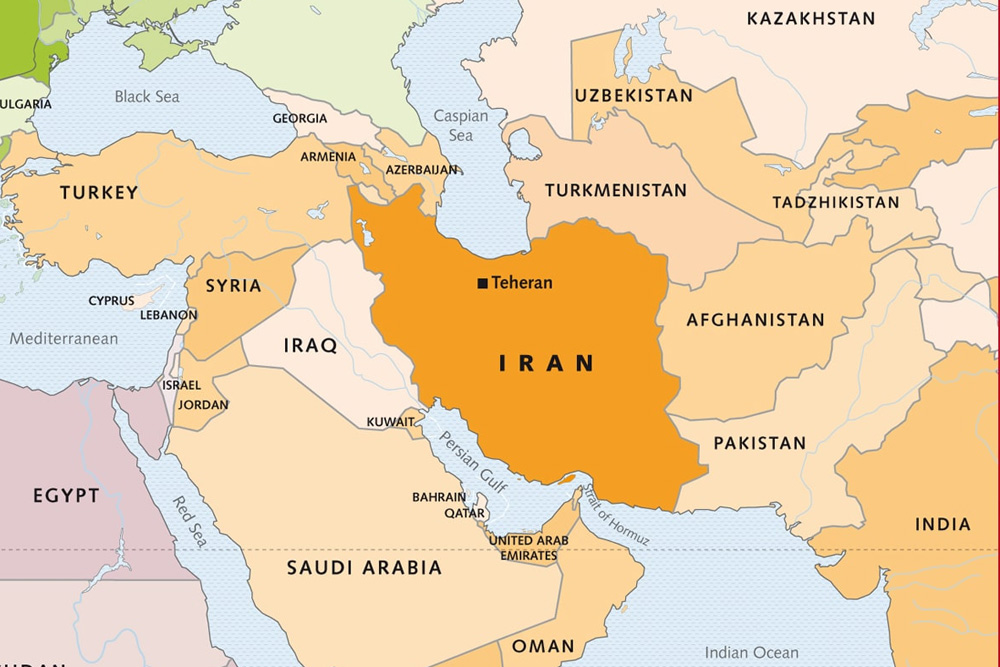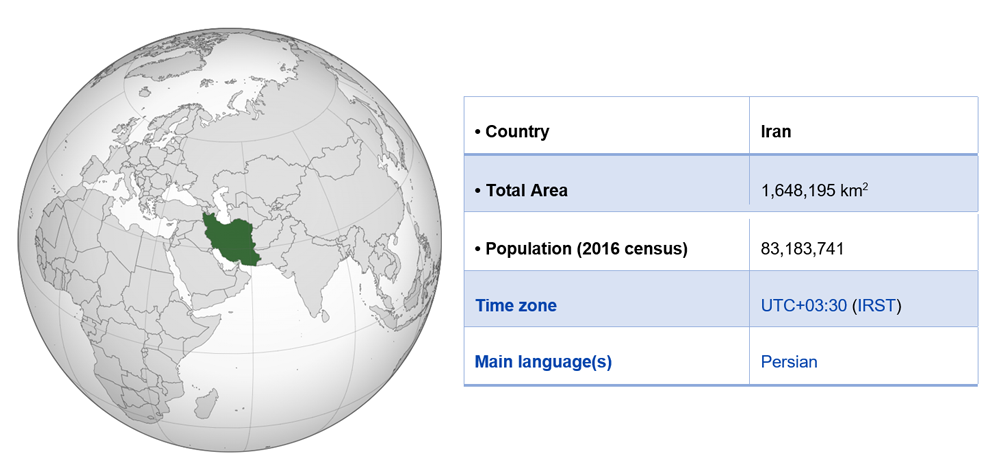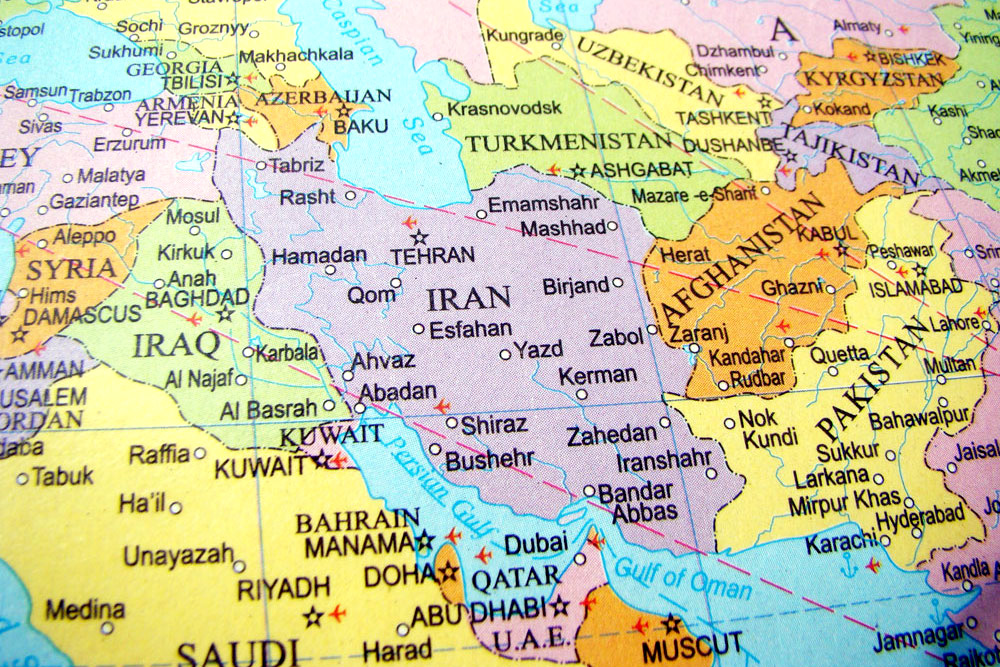
About Iran
Iran is a country in Western Asia. Comprising a land area of 1,648,195 km2 (636,372 sq mi), it is the second largest country in the Middle East and the 17th largest in the world. With an attractive business environment for investment, and having considerable potentials and advantages such as strategic geopolitical situation, climate diversity, economic advantages, energy security and domestic and regional markets, Iran is one of the best choices for your investment.

Geopolitical Situation
Iran with unique geographical location at the heart of a cross-road linking the Middle East, Asia and Europe, empowered by inter and trans-regional trade, customs, tax and investment arrangements.
Having common border on the north by the Caspian Sea and on the south by the Persian Gulf and the Oman Sea, has allowed Iran to access more than 5,800 km of coastal strip. Iran has a privileged position in transit, since having access to the Eurasian countries from the north, east to the Central Asian countries and from the West with a land border with Turkey and thus using a part of the Silk Road.
The geographic location over the transatlantic crossroads has turned the country to the transit axis on the North-South and East-West corridors and so it plays an important role in international economy.
Climatic Characteristics
Iran is one of the world’s most unique countries, in terms of climate with four desirable seasons. There are many climate varieties in Iran and from the word 14 climate, Iran favors 11 climates. This climate diversity has led to a variety of natural landscapes, which can hardly be seen in other countries. Iran has varied nature and climate contains abundant plants and animals which are amazing in both number and variety in comparison with other parts of the world. Iranian Vegetation diversity is more than twice the size of Europe continent and nearly equals the Indian subcontinent.
Energy Security
Compared to the oil and gas producing countries, Iran is ranked 2nd in total proven oil and gas reserves after Russia. This global position allows maximizing national security by providing appropriate strategies for energy security.
Young Educated Human Resources
With its young population and significant part of which are educated and knowledge-based, Iran has specific labor force conditions that are rarely seen in other countries.
Domestic and Regional Market
Iran ranks the world 18th with over 80 mn population and is the second most populous country in the Middle East. There are large middle classes with increased income distribution equality and changing consumption patterns, with annual household net expenditure increasing rapidly.
Surrounded by the consuming countries, which lack the sufficient infrastructures for industrial development, Iran can hold the main part in importing required goods. Additionally, Iran plays a key role since being as a linking chain of North to South and East to West for the transit of goods, swaps (oil swap) and connectivity to international electricity transmission networks.
Iran Economic Advantages
- The 18th largest Economy in the World by Purchasing Power Parity (PPP).
- The Diversified Economy and Broad Industrial Base directly involved in Tehran Stock Exchange (TES) and Iran Fara Bourse (IFB) are the Largest Industrial Base in the MENA region.
- Rich in Natural Resources.
- Labor-Rich Economy
- Young and Educated Population
- Large Domestic Market
- The Middle East market as a Prime Market Opportunity for Iran’s Non-Oil Exports
- Developed Infrastructure in Transportation, Telecommunications and Energy
- Strategic Location, surrounded by 15 Land and Sea Neighbors, Serve as a Lucrative Trade and Transit Route in Both North-South and East-west Directions
- Tax Exemptions and Incentives
- Diversified hydrocarbon-rich economy
- 4th Oil Producer in the World
- 2nd Gas Reserves in the World
- One of the Top Producers of Zinc, Lead, Cobalt, Aluminum, Manganese and Copper in the World.
- Ranks amongst the Top 7 Countries in Producing 22 Important Agricultural Products
| Infrastructure and Population | |
| Sector | Capacity |
| Population | 82820766 |
| Telephones-main lines in use | 30944169 |
| Telephones-mobile cellular | 88341723 |
| Airports | 319 |
| Railways | 13437 km |
| Roadways | 232535 km |
| Electricity-production | 304.4 billion kwh |
New fields of Investment Opportunities & Priorities
- Setting up the rating agencies
- Establishing foreign financial institutions
- Establishing Clusters for Export, Trademarks in agricultural products
- Development of at least 54 Rural Business Clusters.
- Construction and Operation of 98 Rural Industrial Area
- Development of modern irrigation methods
- Development of fisheries and fish farming in cages.
- Water desalination and Sewage.
- Urban wastewater system network, recycling and management of waste and sewage.
- New petrochemical products.
- Construction of power plants with efficiency of 55% to 60%.
- Bunkering.
- PPP Projects.
- Renewable Energy.
- Electronic trading.
- ICT infrastructure development in rural area.
- Knowledge-based companies (start-up’s).
- Urban and suburban rail transport.
- New small ports.
- Exploration, production and utilization of oil and gas fields.

More Information
- CapitalTehran
- Area1,648,195 km2
- CurrencyIranian rial (ریال) (IRR)
- Time zoneUTC+3:30 (IRST)
- Calling code+98
- Population • 2019 estimate83,183,741 (17th)
